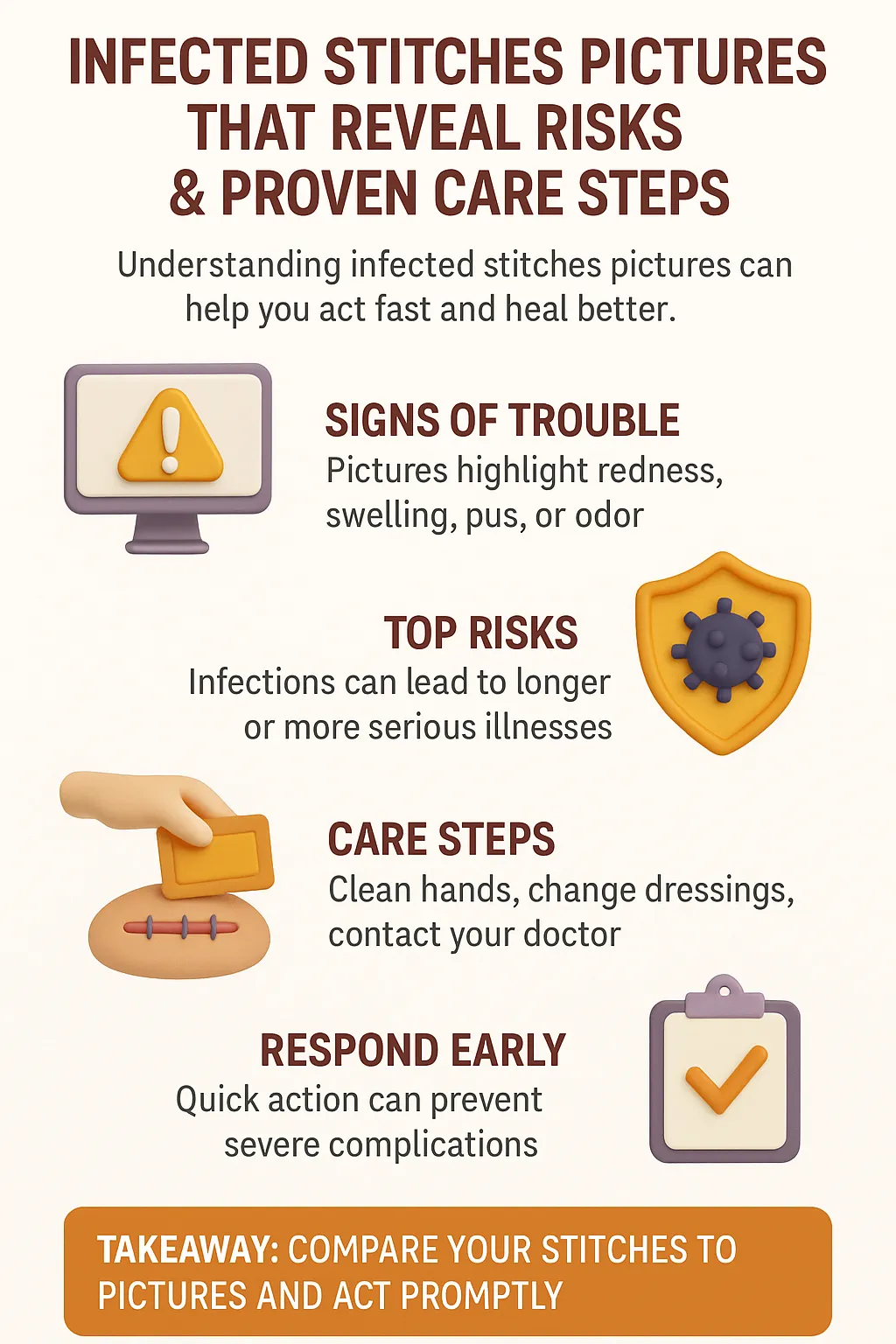If you’ve ever stared at your stitches and asked yourself, “Is this normal?”, you’re not alone. In my experience working with post-surgical patients, the difference between normal healing and early infection can be very subtle. That’s why this page goes beyond surface-level advice—you’ll see infected stitches pictures that illustrate the risks clearly, paired with proven care steps to help you act early, avoid unnecessary worry, and protect your recovery.
Top Takeaways
- Use visuals: Infection pictures are powerful tools for comparison.
- Spot red flags: Redness, swelling, pus, odor, fever, or pain.
- Know the numbers: Around 500,000 SSIs occur each year in the U.S.
- Act promptly: Call your provider at the first warning sign.
- Follow care steps: Pictures raise awareness, but proven care practices prevent complications.
What Infected Stitches Pictures Reveal and Why Care Steps Matter
Pictures of infected stitches help you distinguish between healthy healing and infection. Normal stitches often show mild redness or tenderness that improves with time. Infected stitches, on the other hand, may appear increasingly red, swollen, or painful, with pus or odor developing.
By looking at early, moderate, and severe examples, you can see how subtle changes—like cloudy drainage or expanding redness—signal that professional help is needed. Pairing these visuals with proven wound care steps—clean hands, fresh dressings, and following medical instructions—creates a stronger safeguard for recovery.
If your stitches resemble severe infected images, especially alongside fever or worsening pain, it’s a clear signal to seek medical care immediately.
Expert Insight
“In my experience caring for post-surgical wounds, patients often overlook the earliest changes—like redness that spreads or thicker drainage. Using pictures as reference points, along with simple daily care routines, can make the difference between smooth healing and a serious setback.”
Case Study & Real-World Examples
Catching Infection Early – Maria’s Story
- 42-year-old recovering from abdominal surgery.
- Day 3: noticed redness and swelling.
- Compared to infection pictures → saw spreading redness.
- Called her doctor and started antibiotics.
- Outcome: Infection stopped early, recovery went smoothly.
Delaying Care – James’s Story
- 29-year-old recovering from knee surgery.
- Assumed pain and swelling were “normal.”
- Within a week: thick yellow discharge + odor.
- Required in-office wound cleaning + stronger antibiotics.
- Later admitted: “If I had used reference pictures earlier, I’d have acted sooner.”
Key Lesson: Small details matter. Patients who use reliable pictures and follow care steps detect problems earlier, avoid delays, and recover faster, especially when supported by a multidisciplinary approach that integrates medical expertise, wound care guidance, and patient awareness.
Supporting Statistics & Care Insights
- 500,000 surgical site infections happen in the U.S. each year.
Proven Care Step: Prevent infection with clean hands, correct dressing changes, and quick reporting of unusual changes.
Final Thought & Opinion
Looking at infected stitches pictures isn’t about fear—it’s about awareness. In my experience, patients who compare their healing to reliable images and follow proven care steps are the ones who recover with fewer complications.
My opinion: Pictures build confidence and awareness, while proven daily care routines are what truly protect healing. Together, they are one of the most effective safeguards for safe recovery.
Next Steps
- Compare: Use trusted infection pictures.
- Check: Look for redness, swelling, pus, odor, fever, or pain.
- Document: Take daily photos of your wound.
- Contact: Call your provider if warning signs appear.
- Prevent: Wash hands, follow instructions, change dressings as directed.
Remember: Early action and consistent care steps can save you from serious complications, and in more advanced cases, timely chronic wound care treatment can make the difference between prolonged healing and effective recovery.
Frequently Asked Questions (FAQs)
What risks do infected stitches pictures reveal?
They show clear warning signs—like spreading redness, swelling, pus, or foul odor—that indicate a higher risk of delayed healing, deeper infection, or complications if left untreated.
How can proven care steps reduce infection risks?
Simple actions like washing hands before touching stitches, keeping the wound clean and dry, and changing dressings as directed significantly lower the chance of infection.
When should I compare my wound to infected stitches pictures?
Check your stitches daily during the first 30 days after surgery (or up to 90 days if implants are involved). This is the critical window when most infections appear.
Do infected stitches pictures replace medical advice?
No. Pictures help you spot differences between normal healing and infection, but they cannot replace a doctor’s evaluation. Always contact your provider if you’re unsure.
What should I do if my wound looks like the infected stitches pictures?
Document the changes with photos, avoid touching or removing stitches yourself, and contact your healthcare provider immediately for proper treatment.
When reviewing infected stitches pictures that reveal risks & proven care steps, it becomes clear that both wound care and the surrounding environment play critical roles in recovery. Just as proper cleaning and monitoring prevent infection from spreading at a wound site, clean indoor air supports overall healing. High-quality filtration, such as the 15x25x4 MERV 11 Air Filters, helps reduce airborne particles that may exacerbate health risks. Likewise, professional services like Air Duct Sealing Company ensure that air systems operate efficiently, minimizing contaminants that could compromise vulnerable individuals. For added reliability, homeowners often turn to products such as the 20x24x2 Pleated Furnace Filters or the 20x20x1 MERV 11 Pleated HVAC AC Furnace Air Filters (5-Pack), both designed to trap allergens and bacteria that can worsen recovery conditions. Even budget-friendly options, like the HVAC Furnace Filter listing on eBay, provide practical solutions for keeping the air clean. By combining careful wound monitoring with a purified home environment, patients can reduce infection risks and support better healing outcomes.




